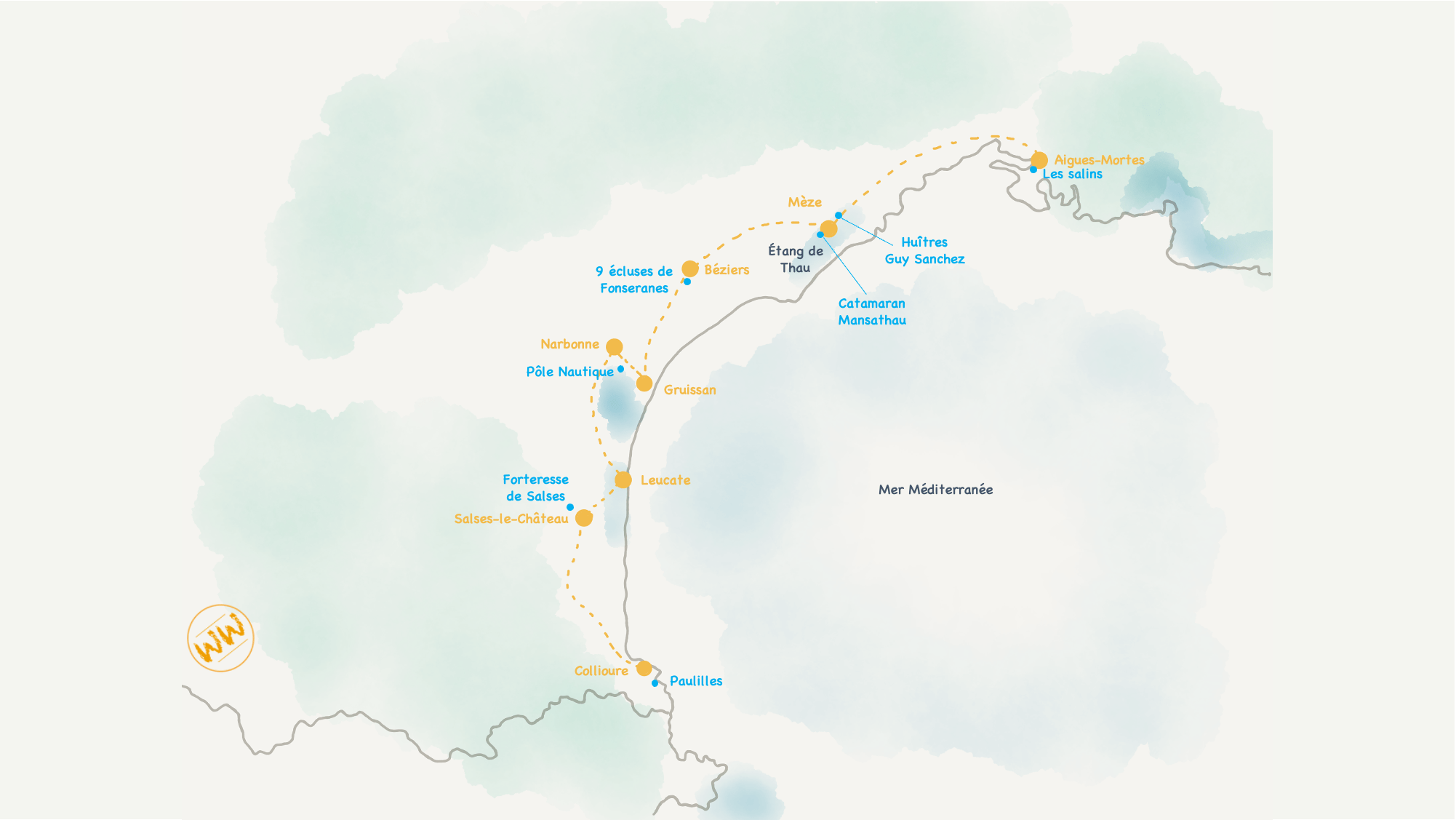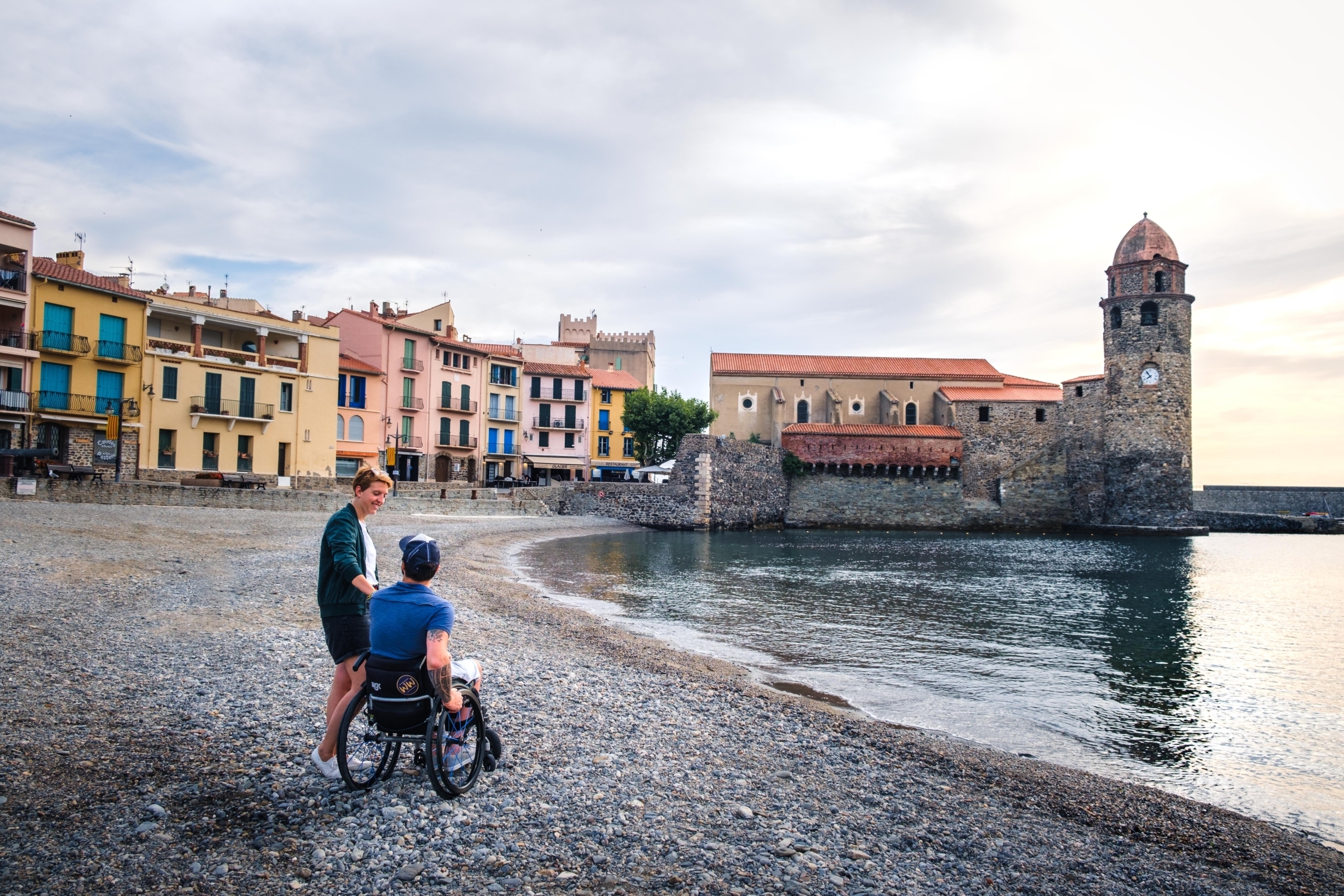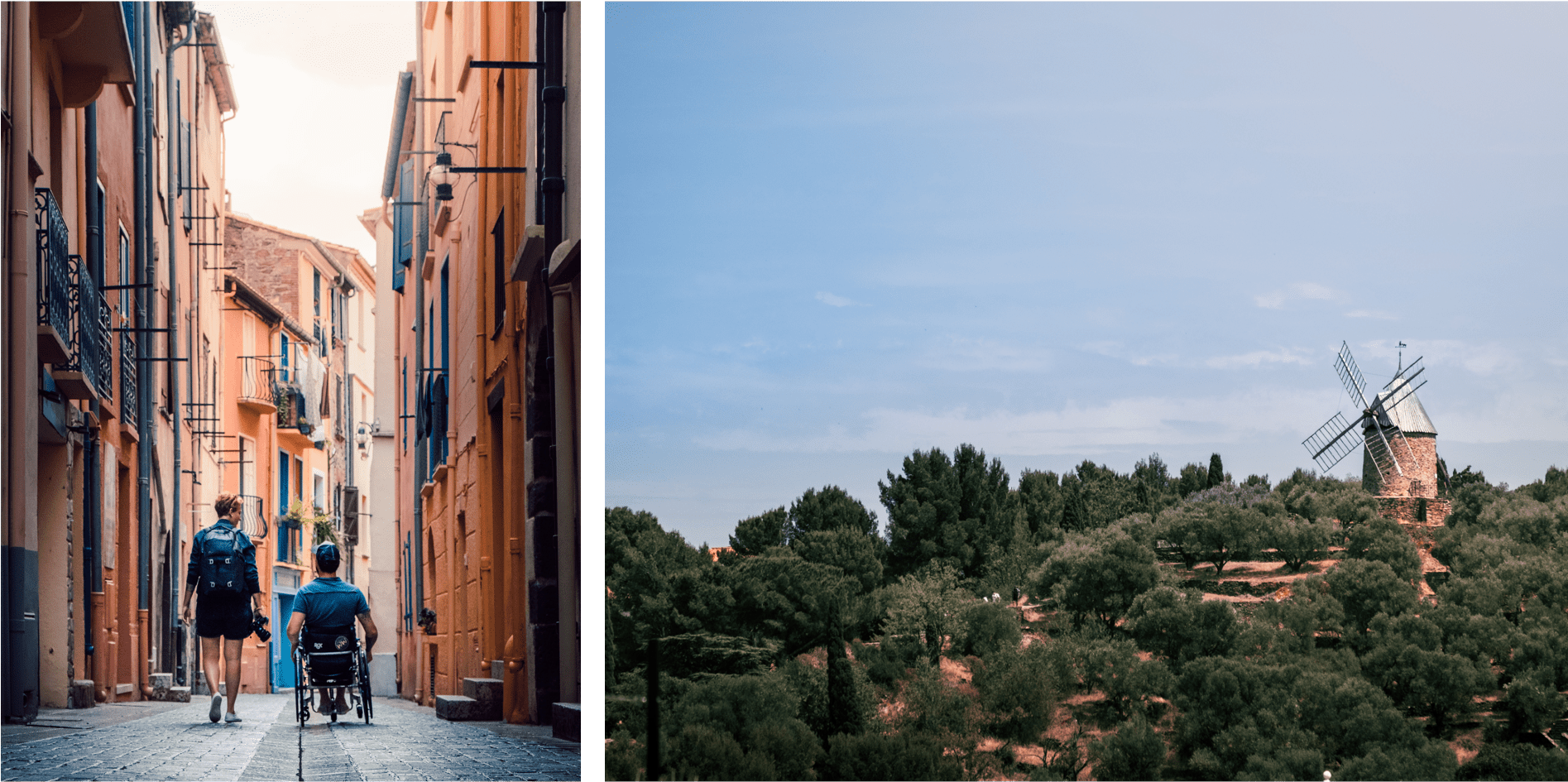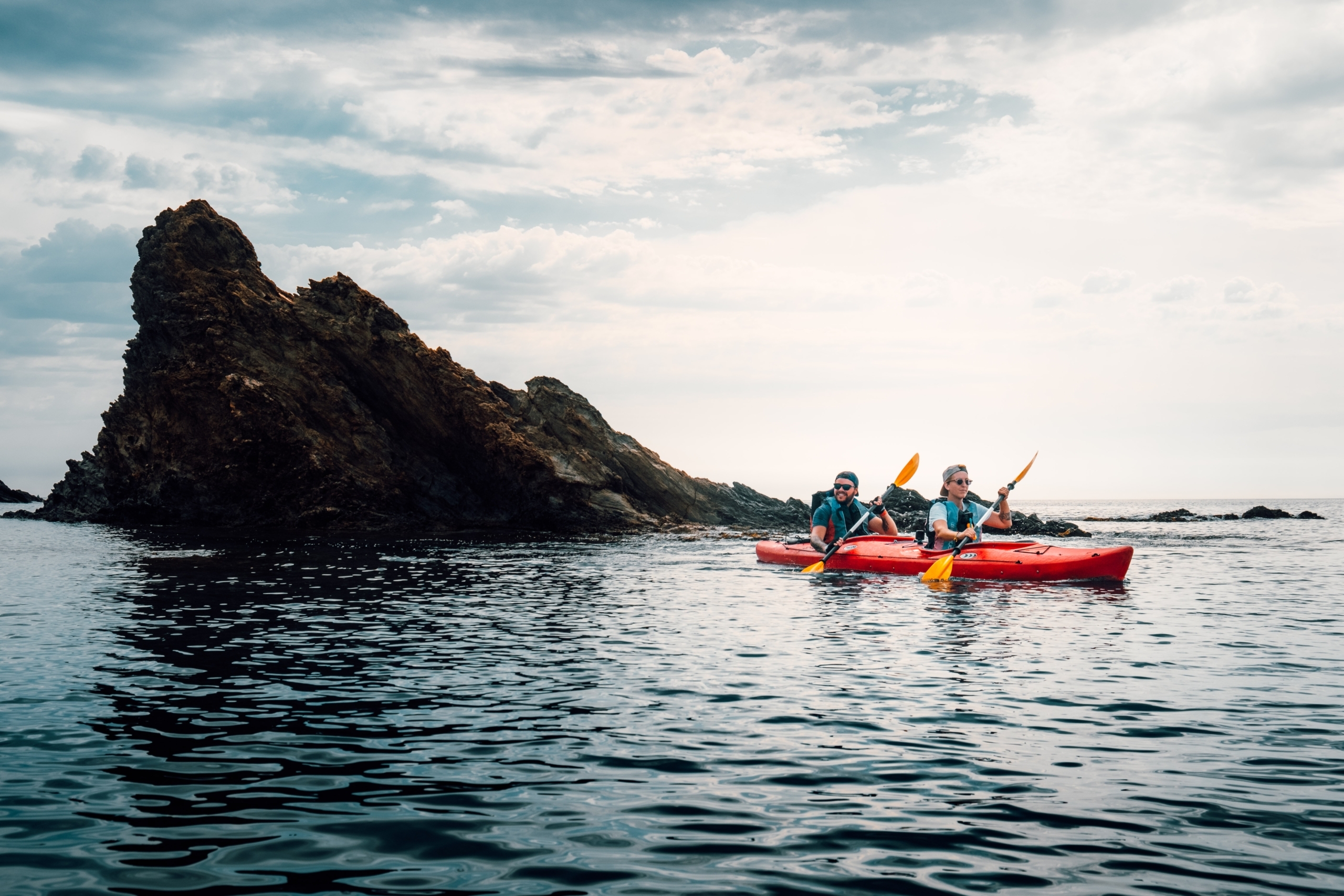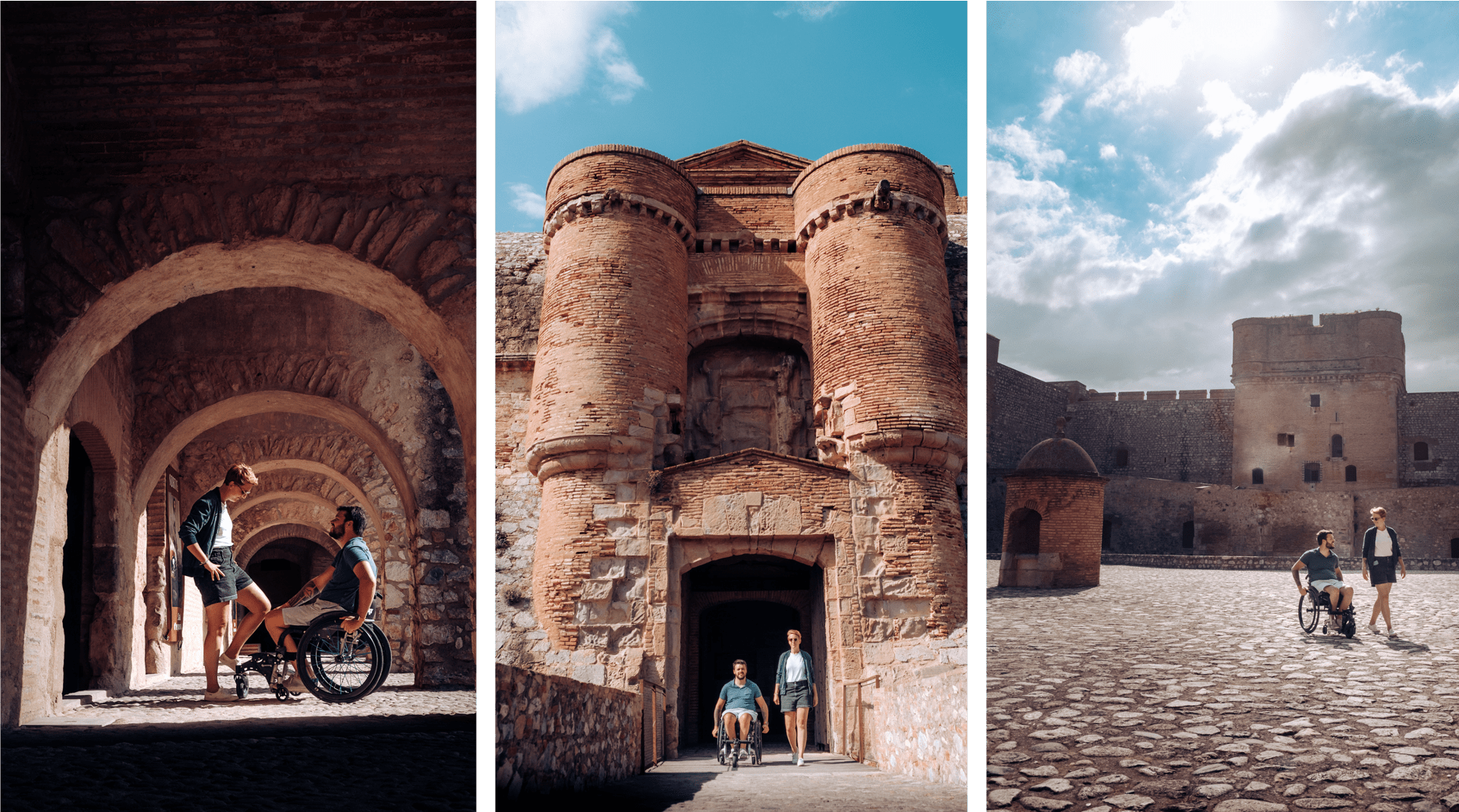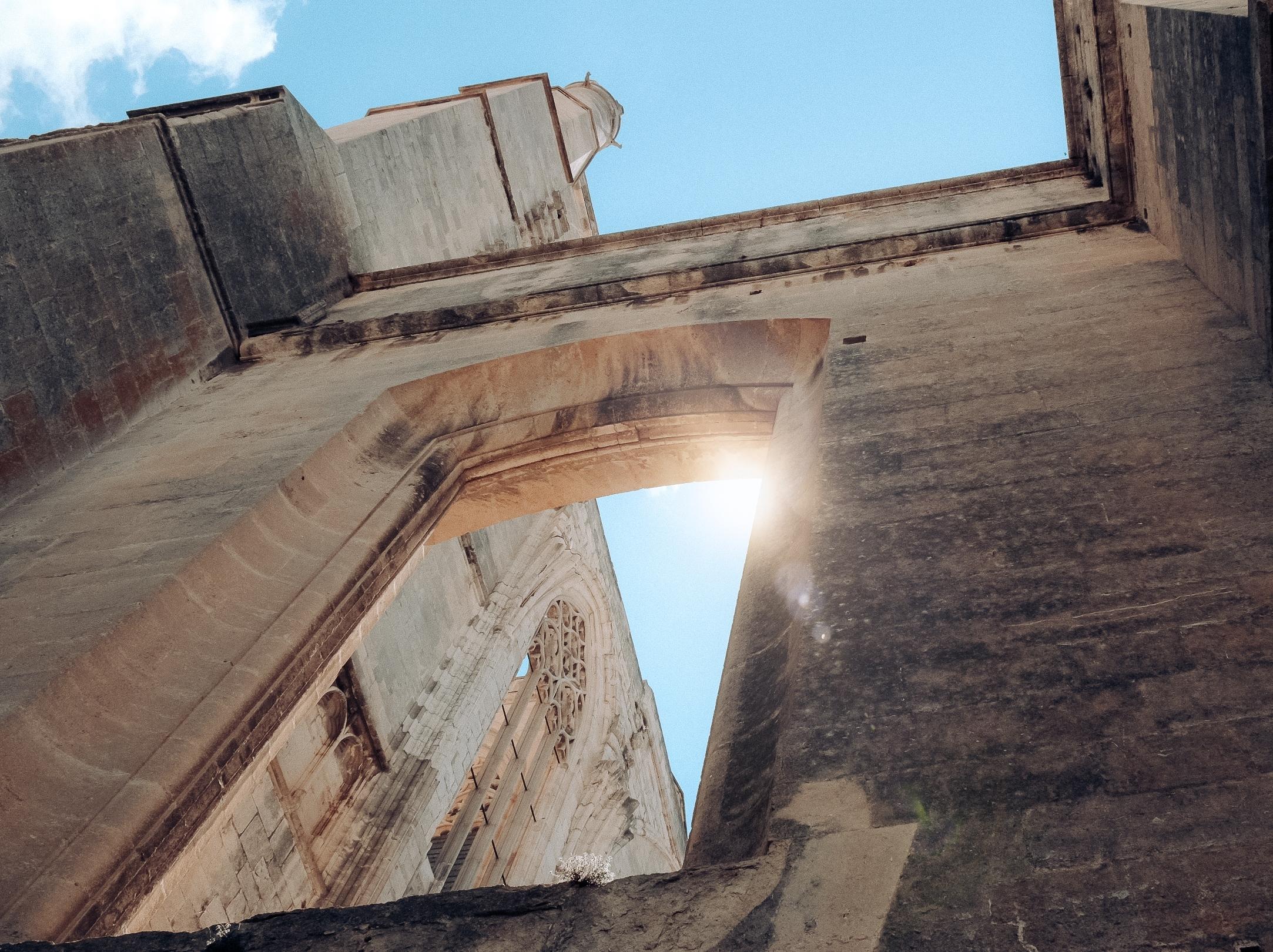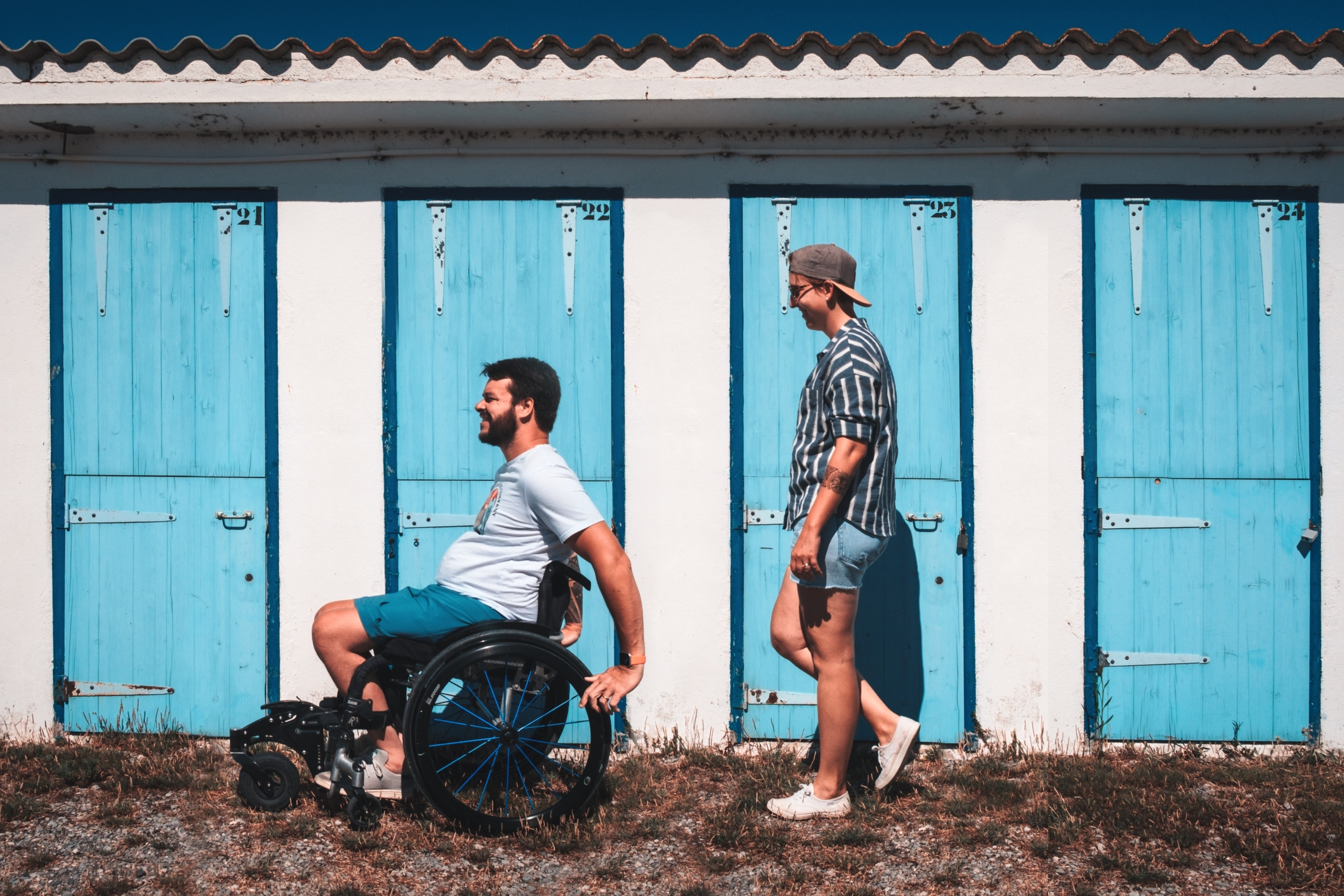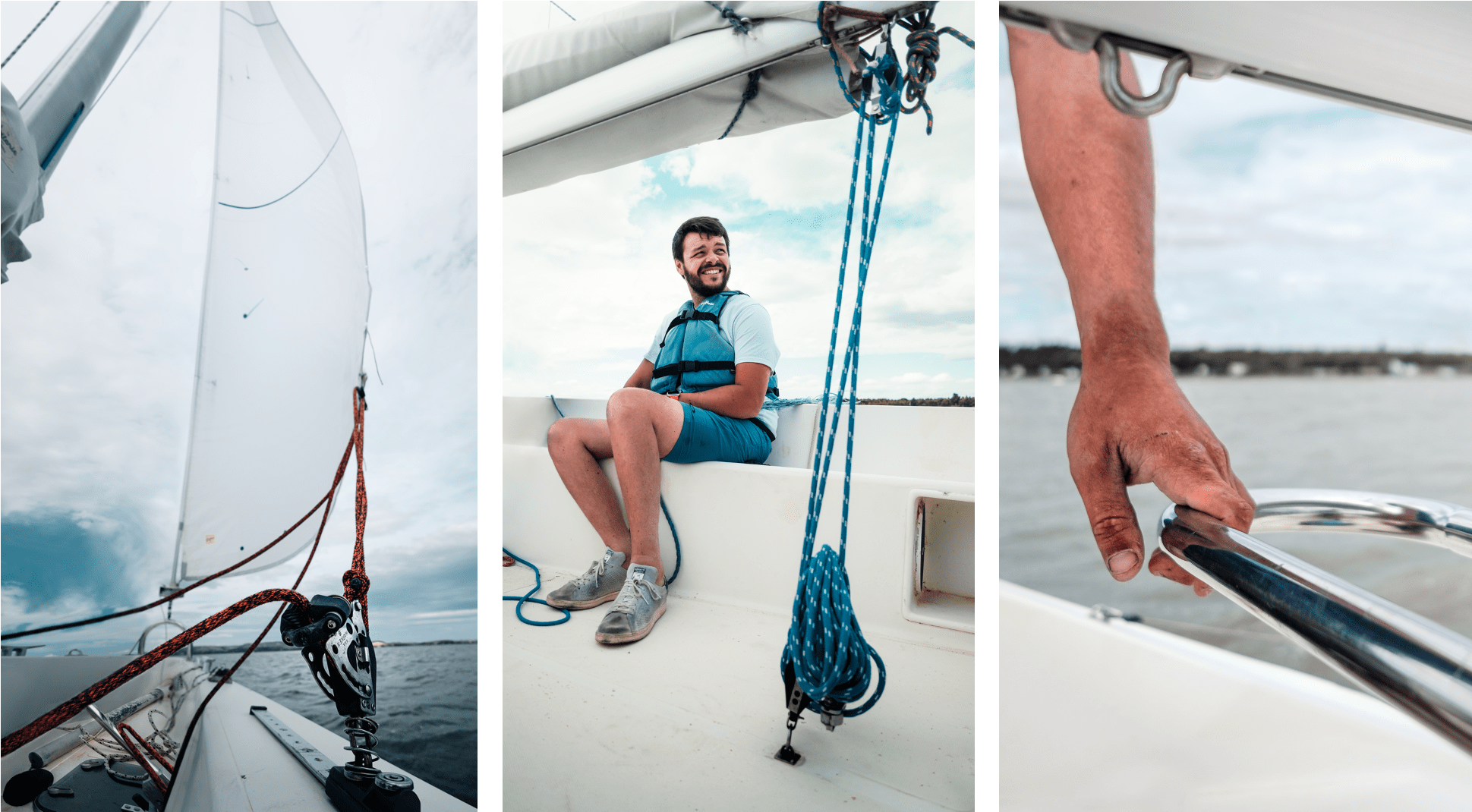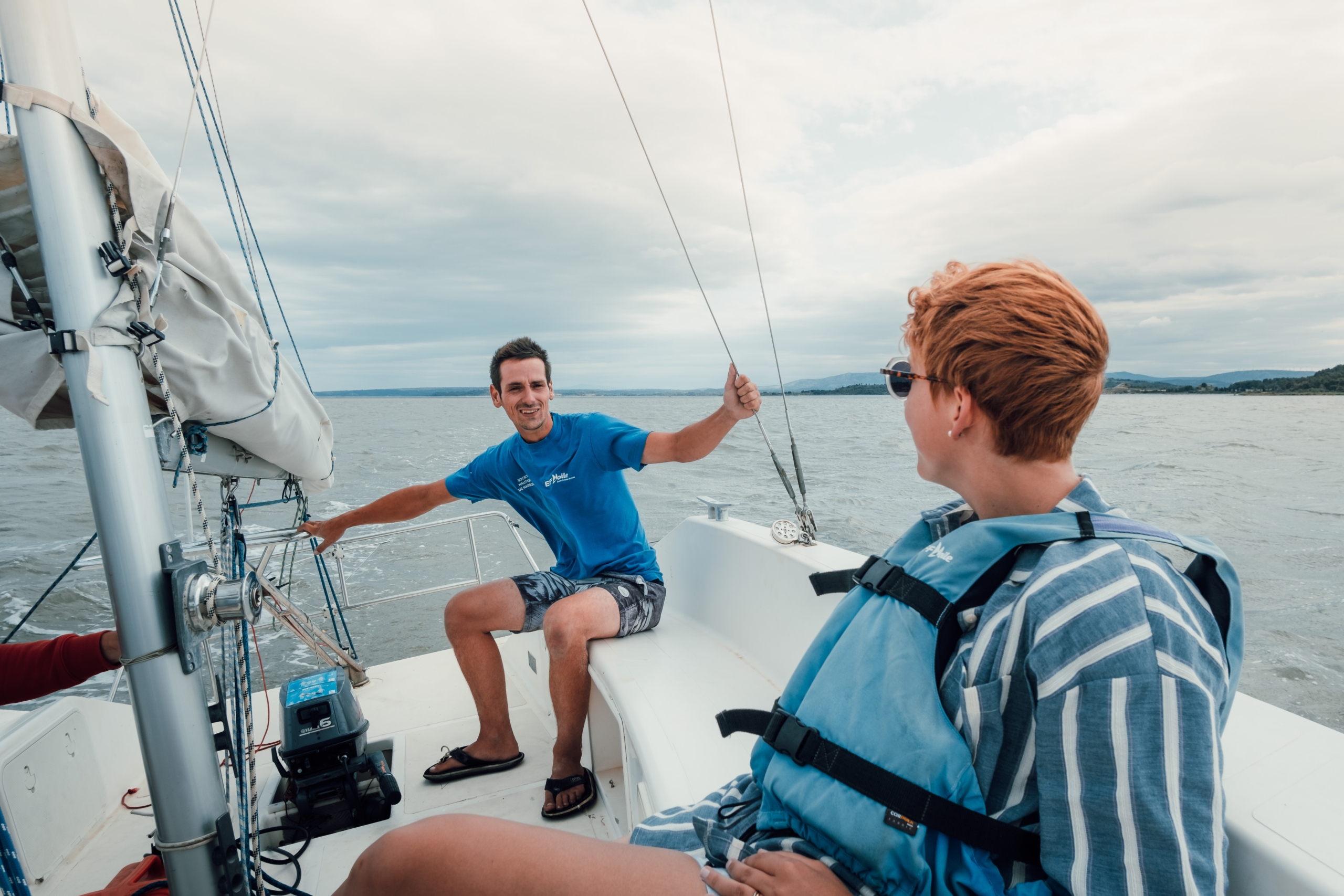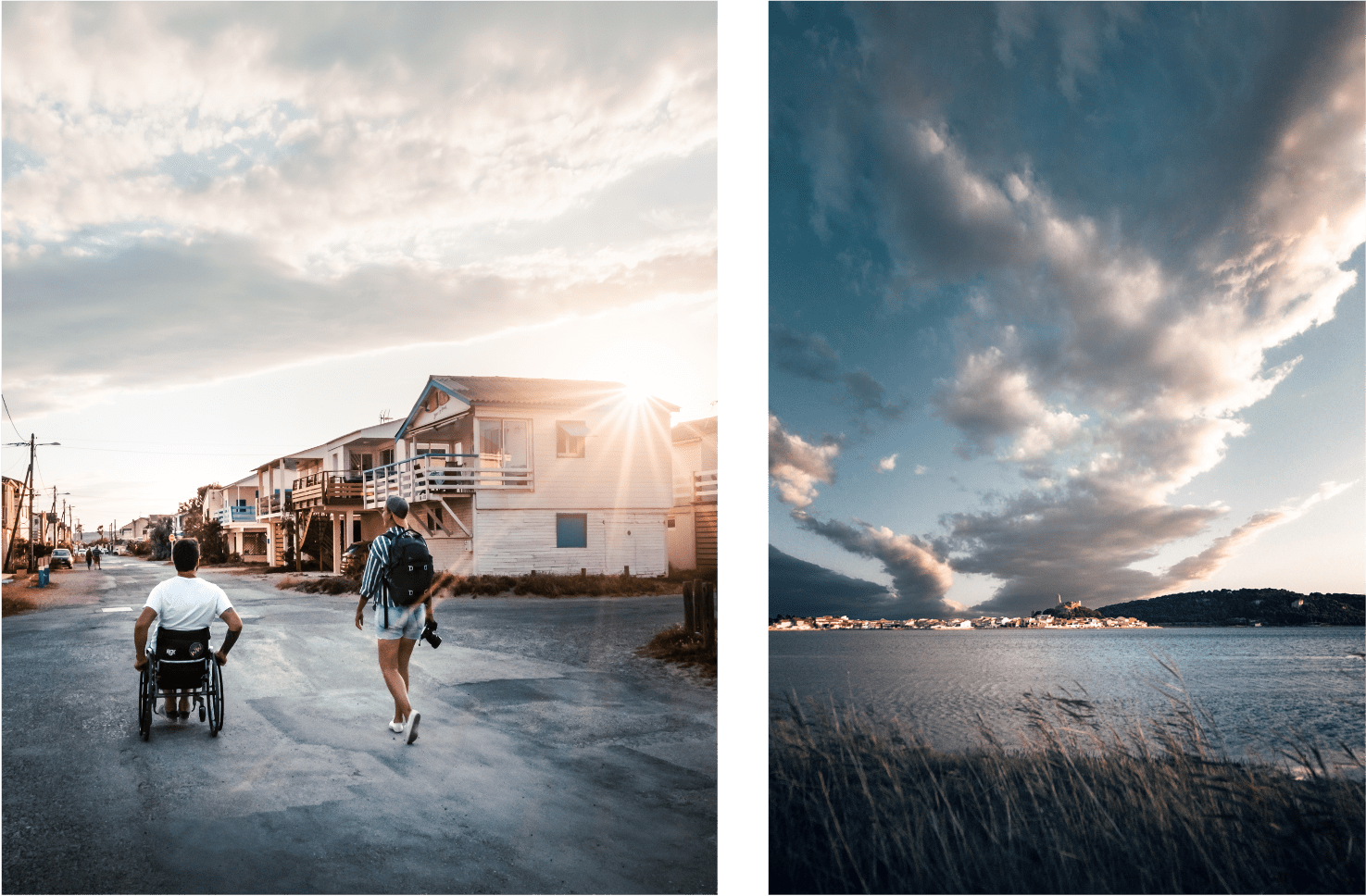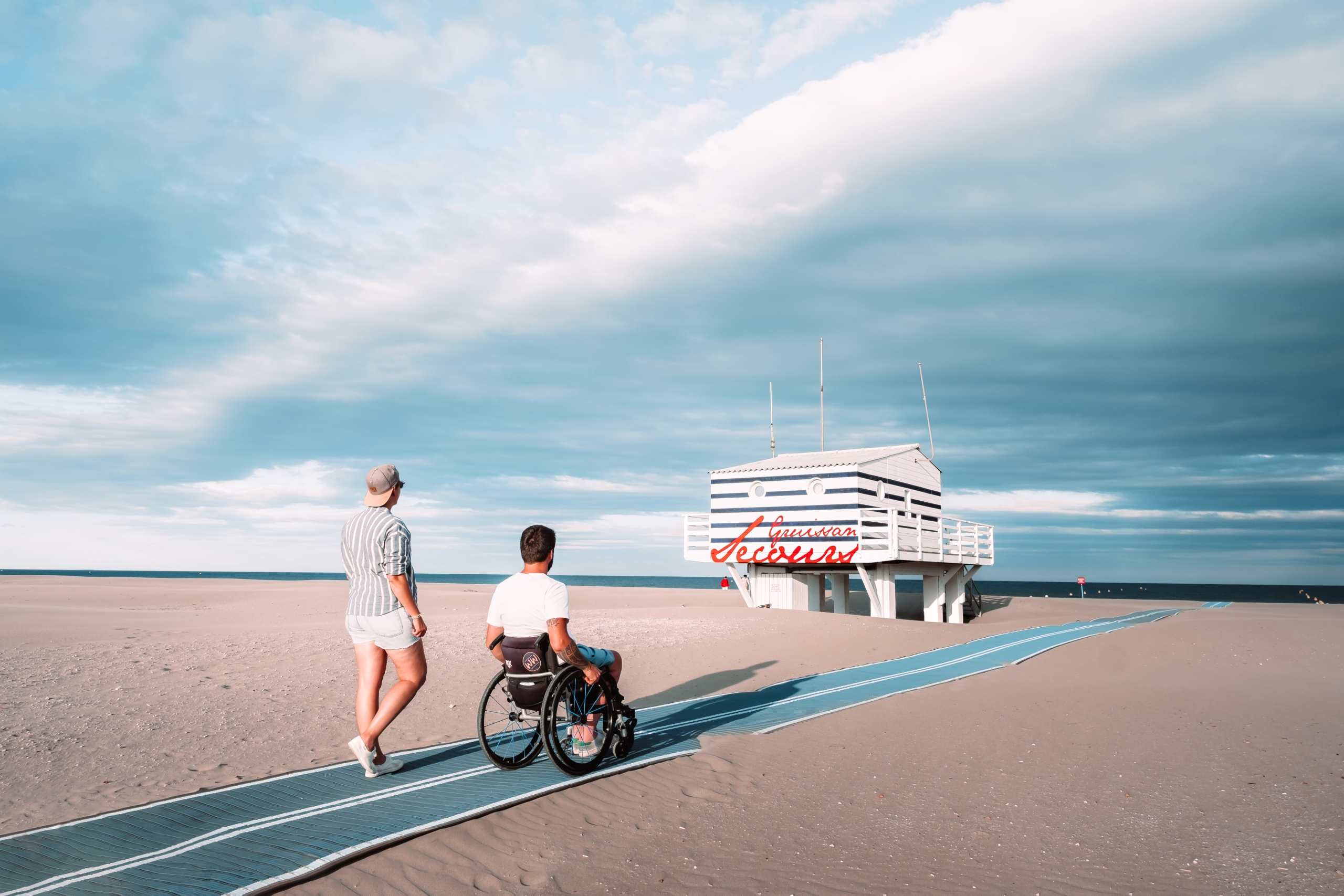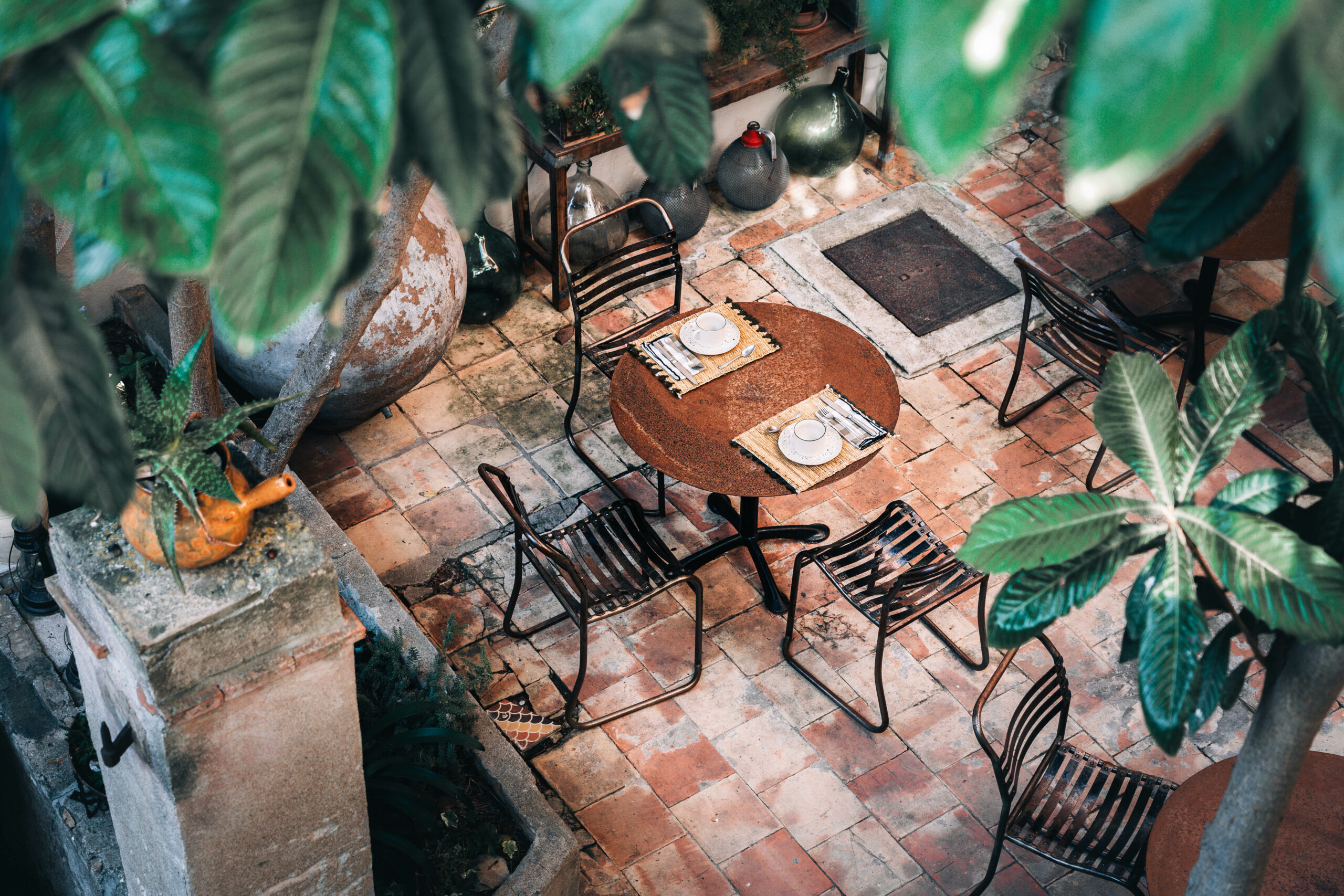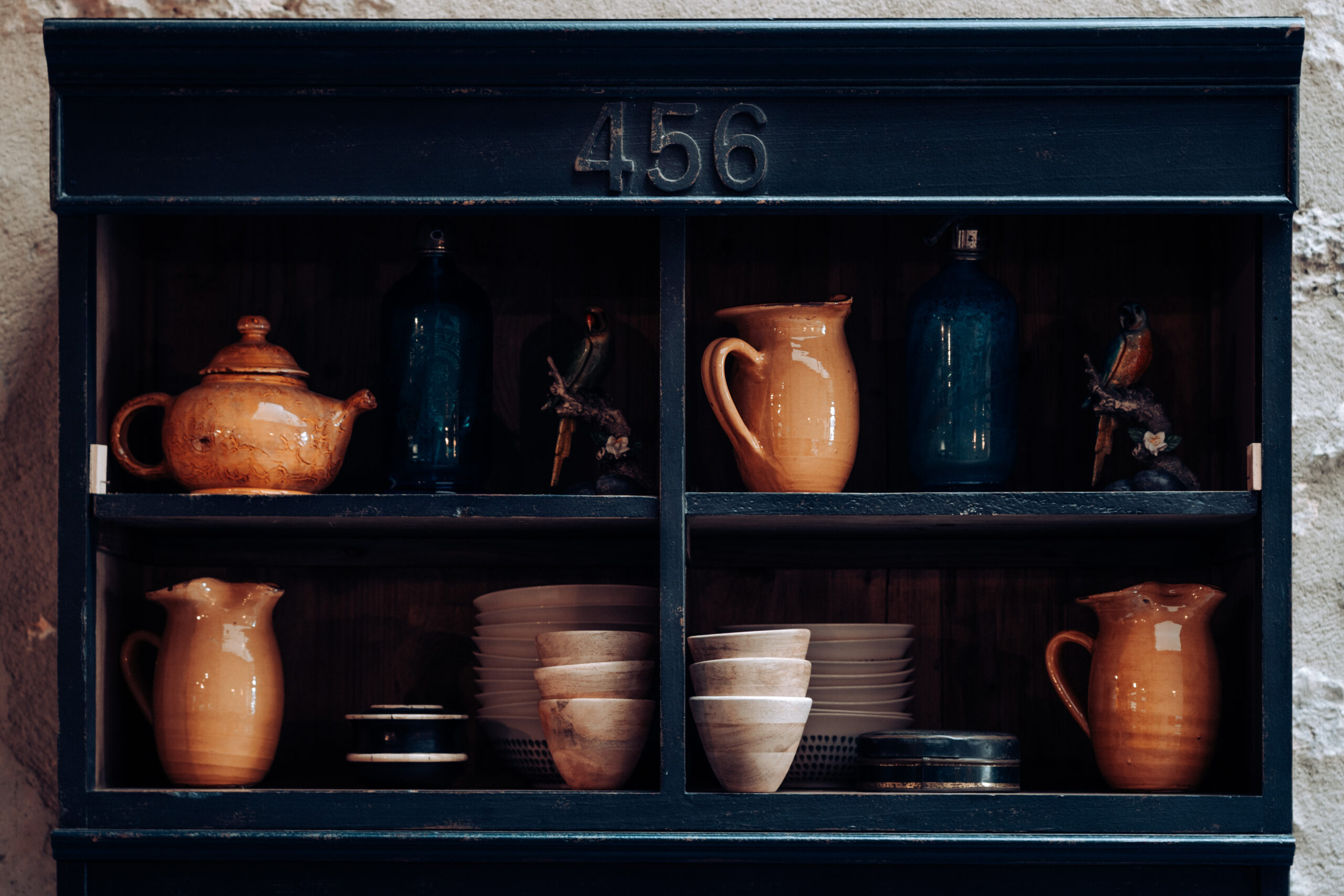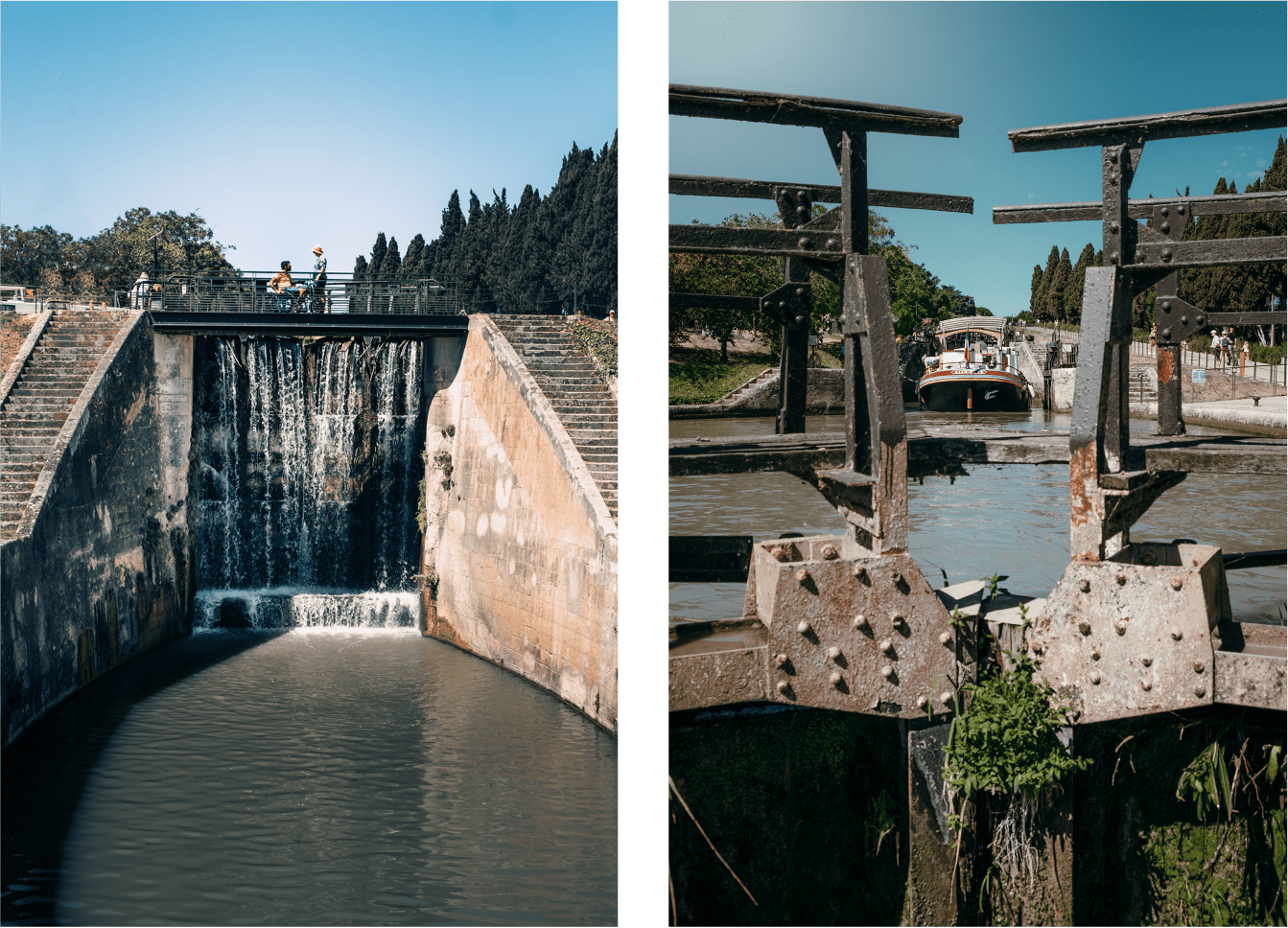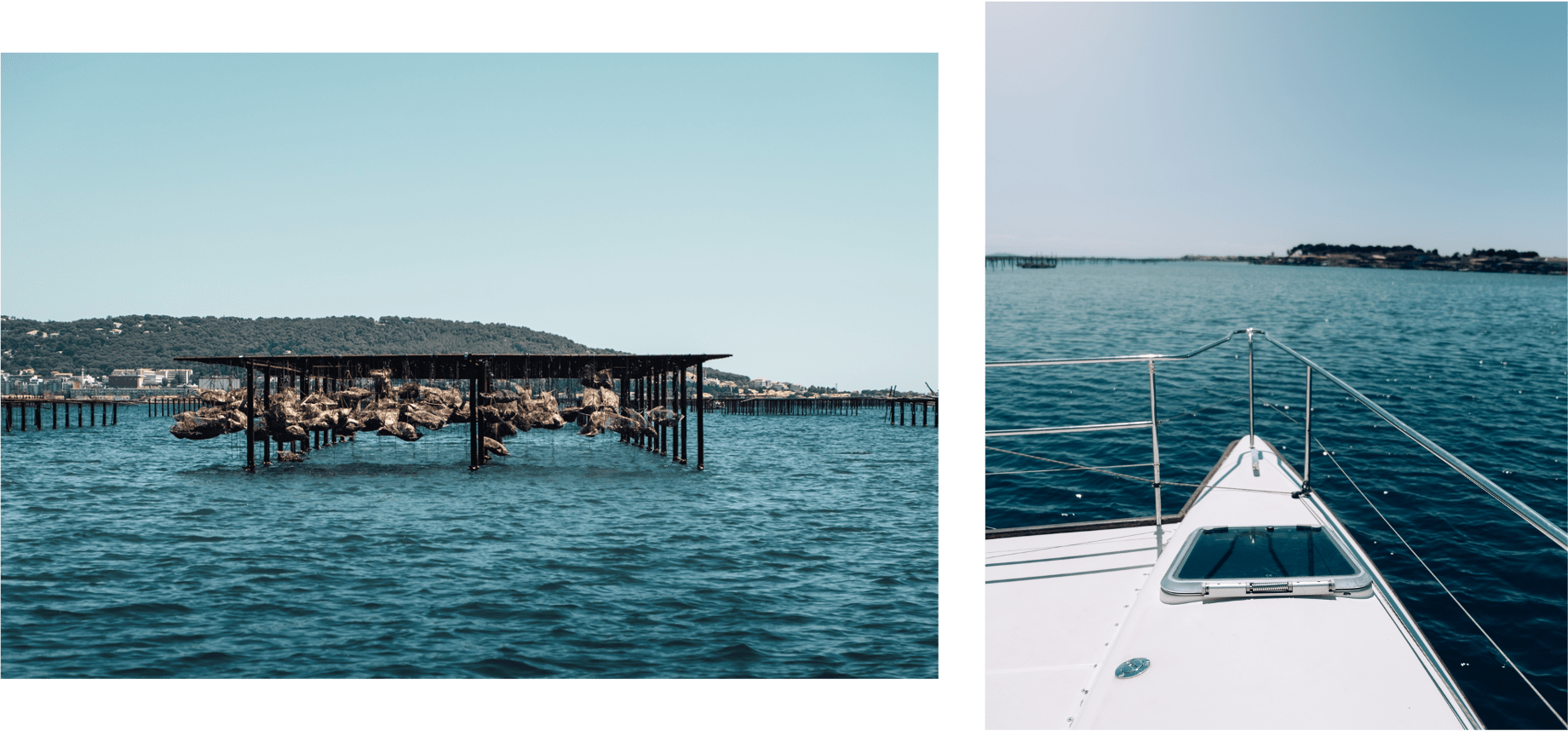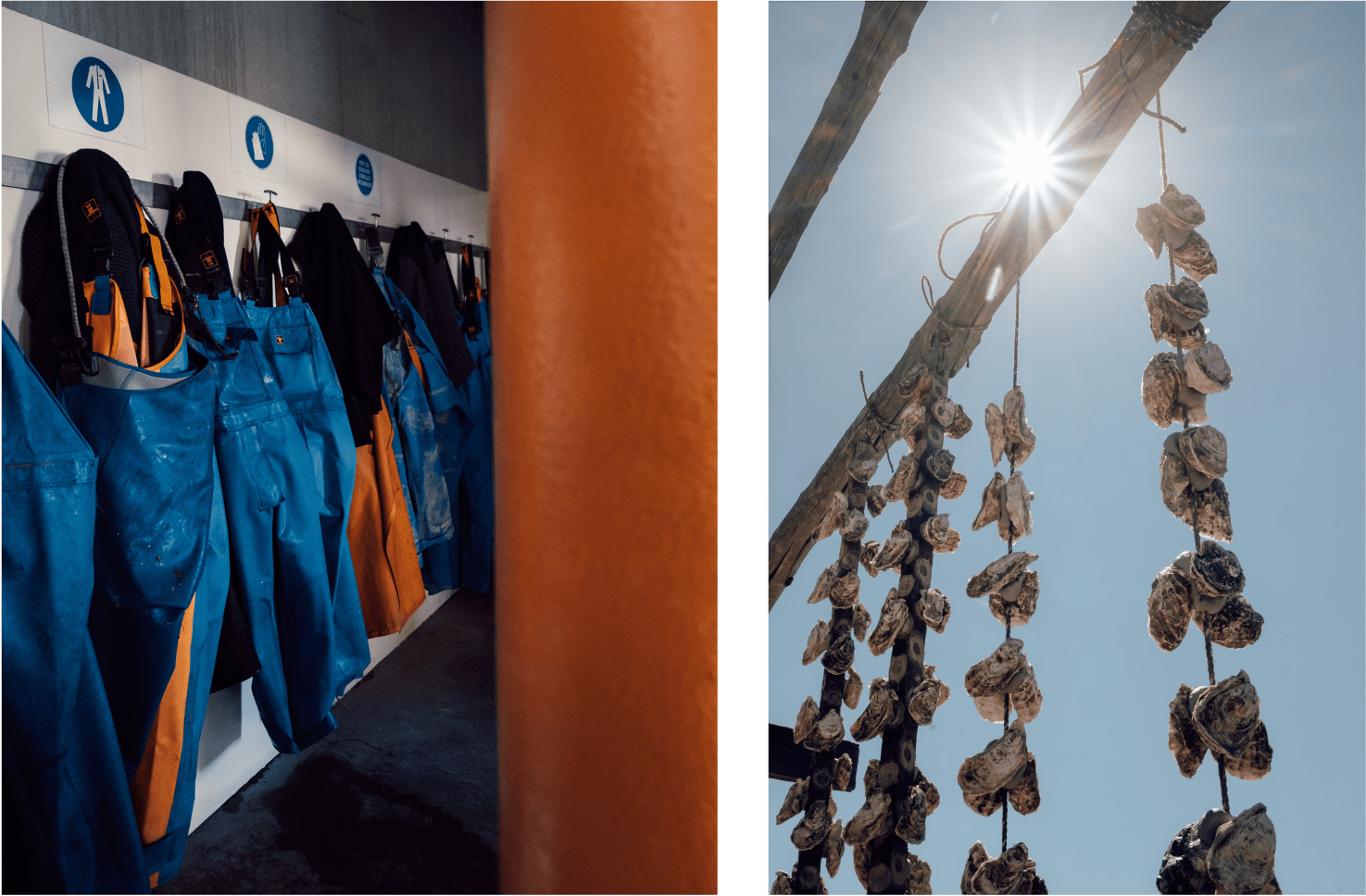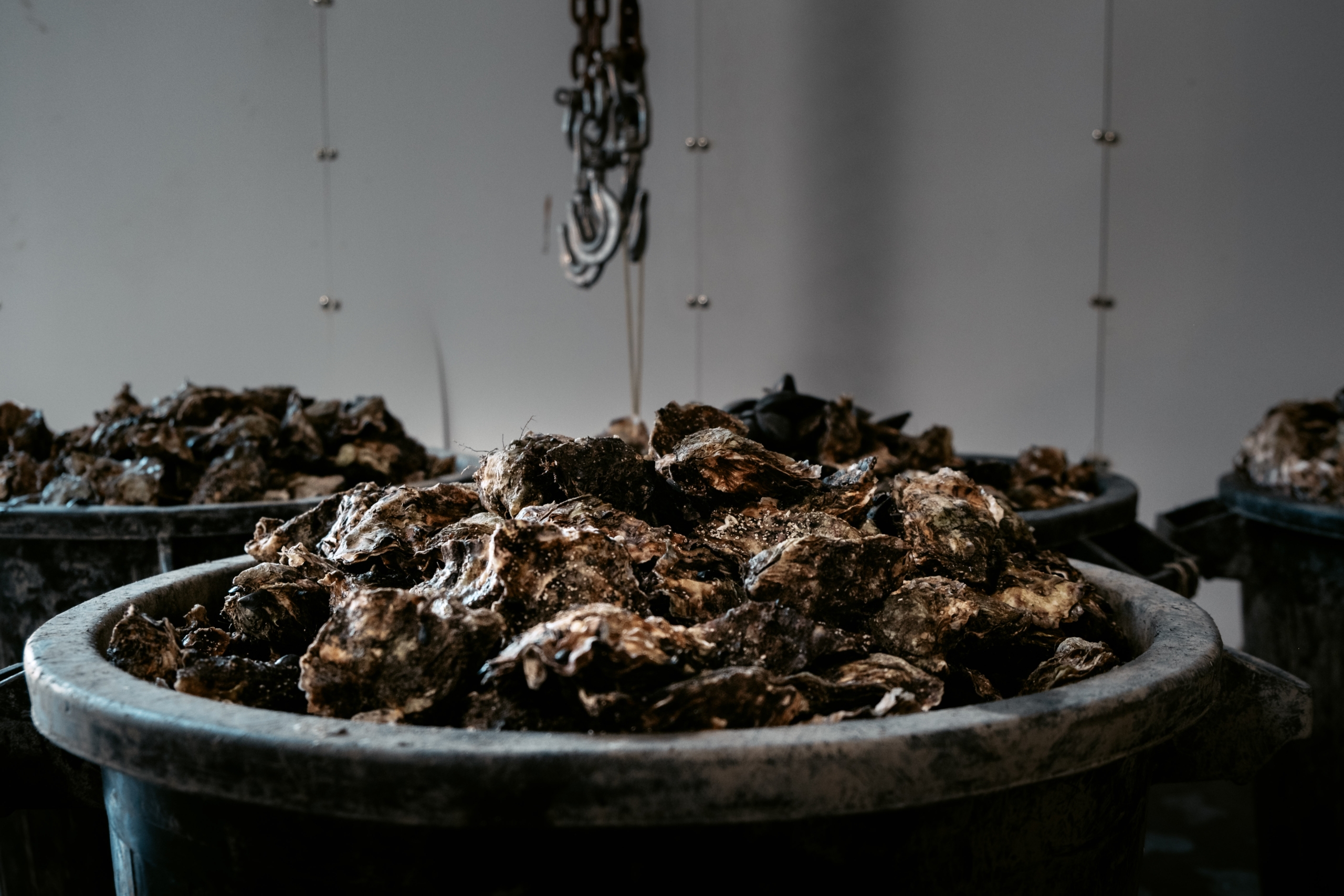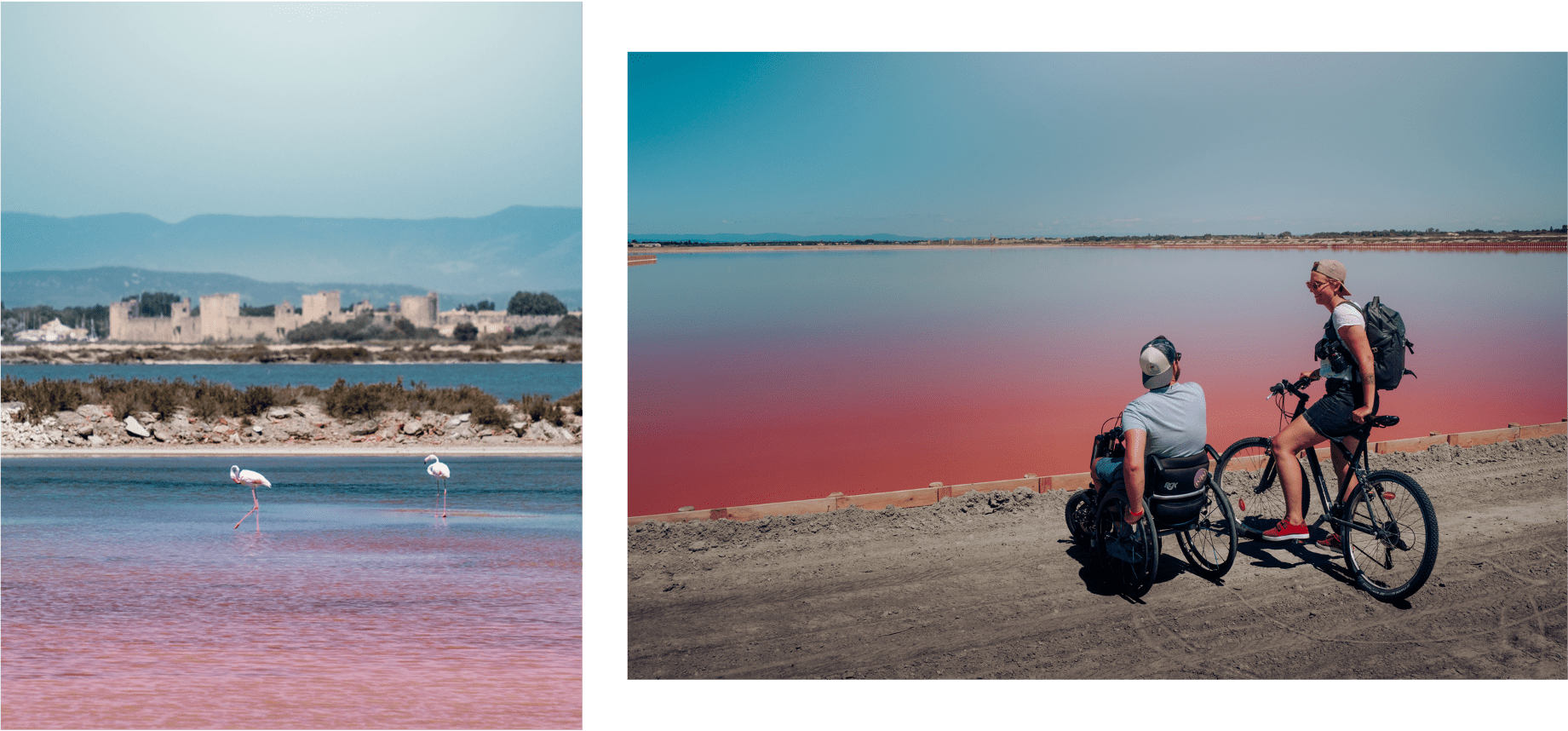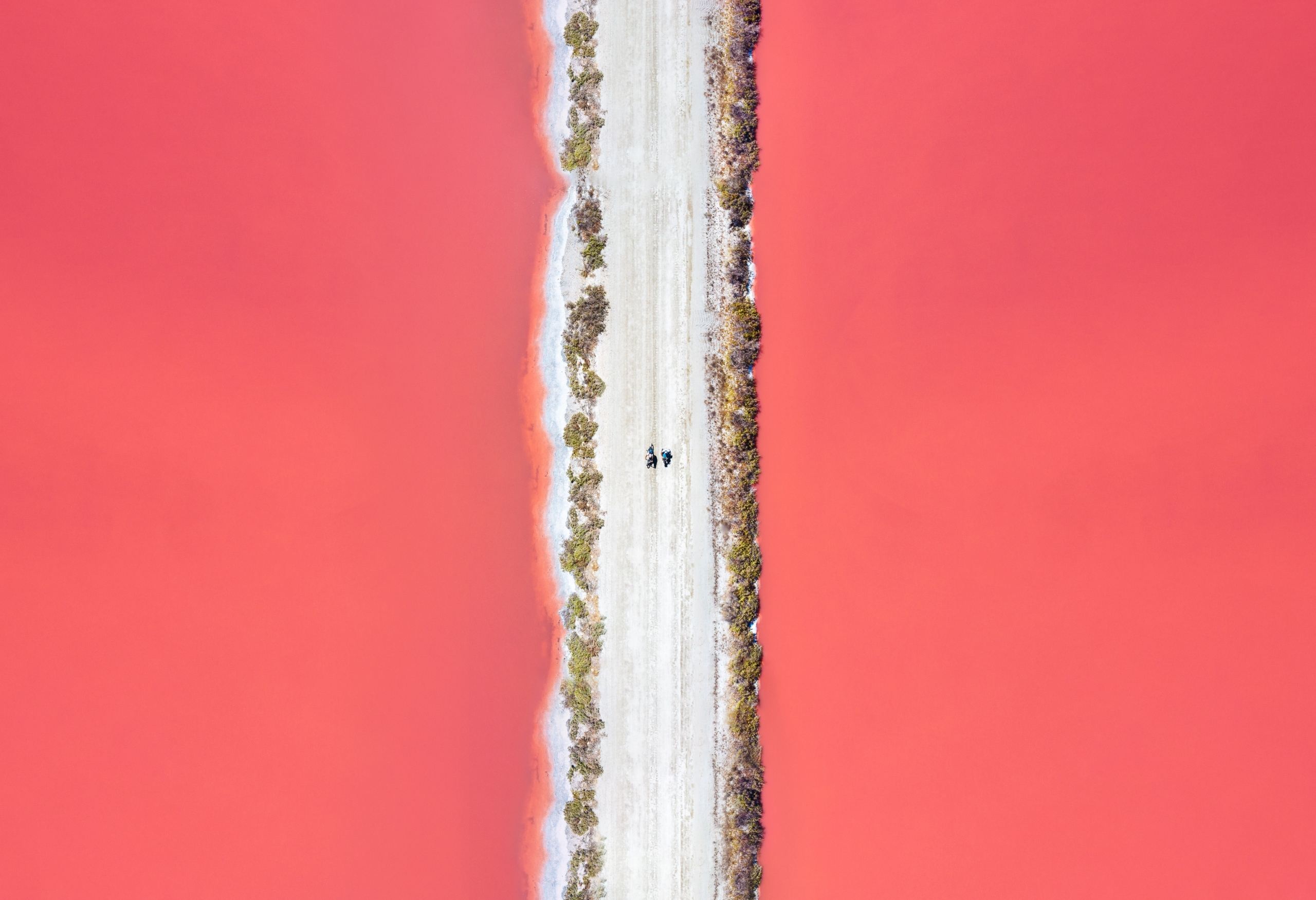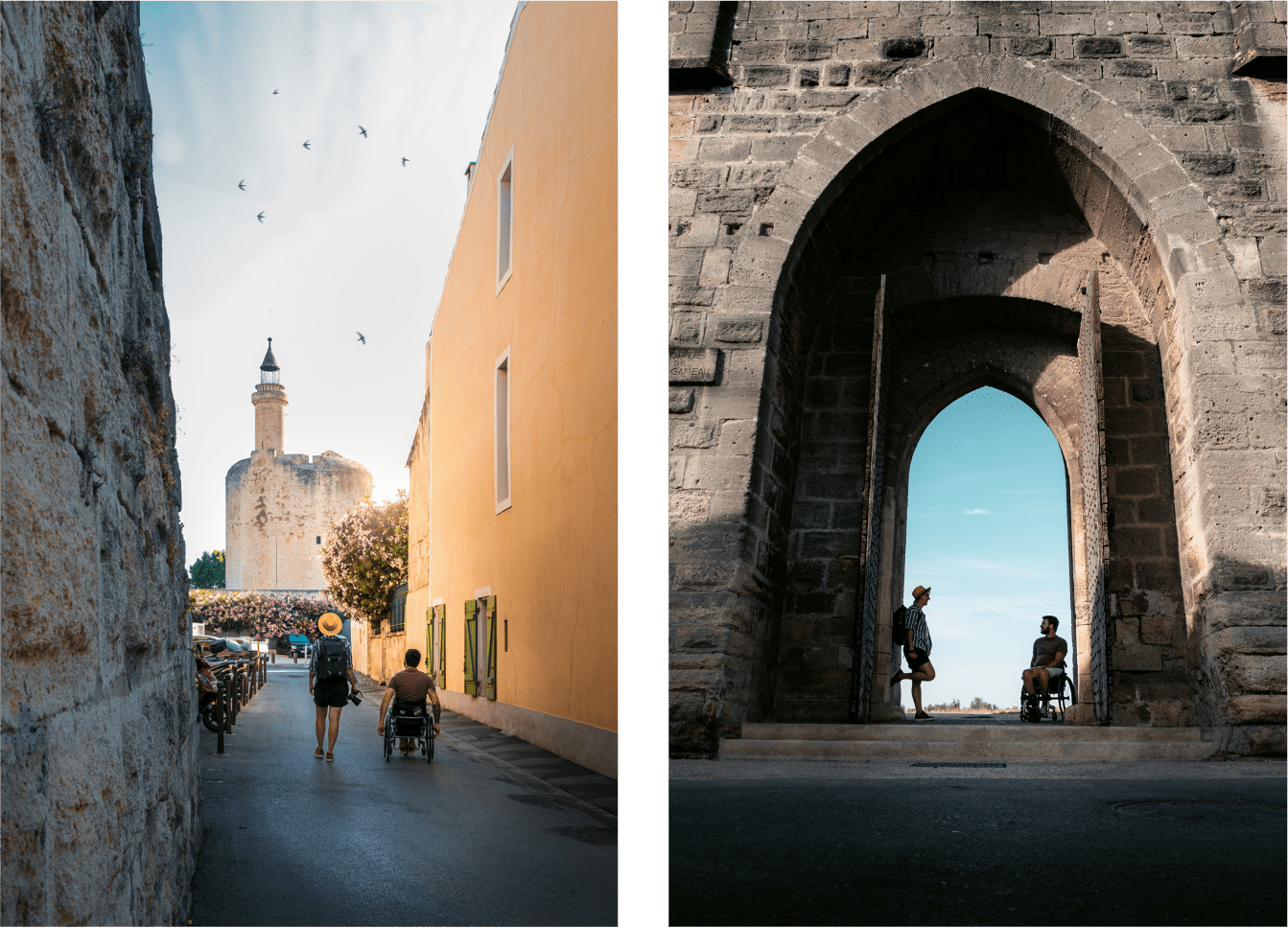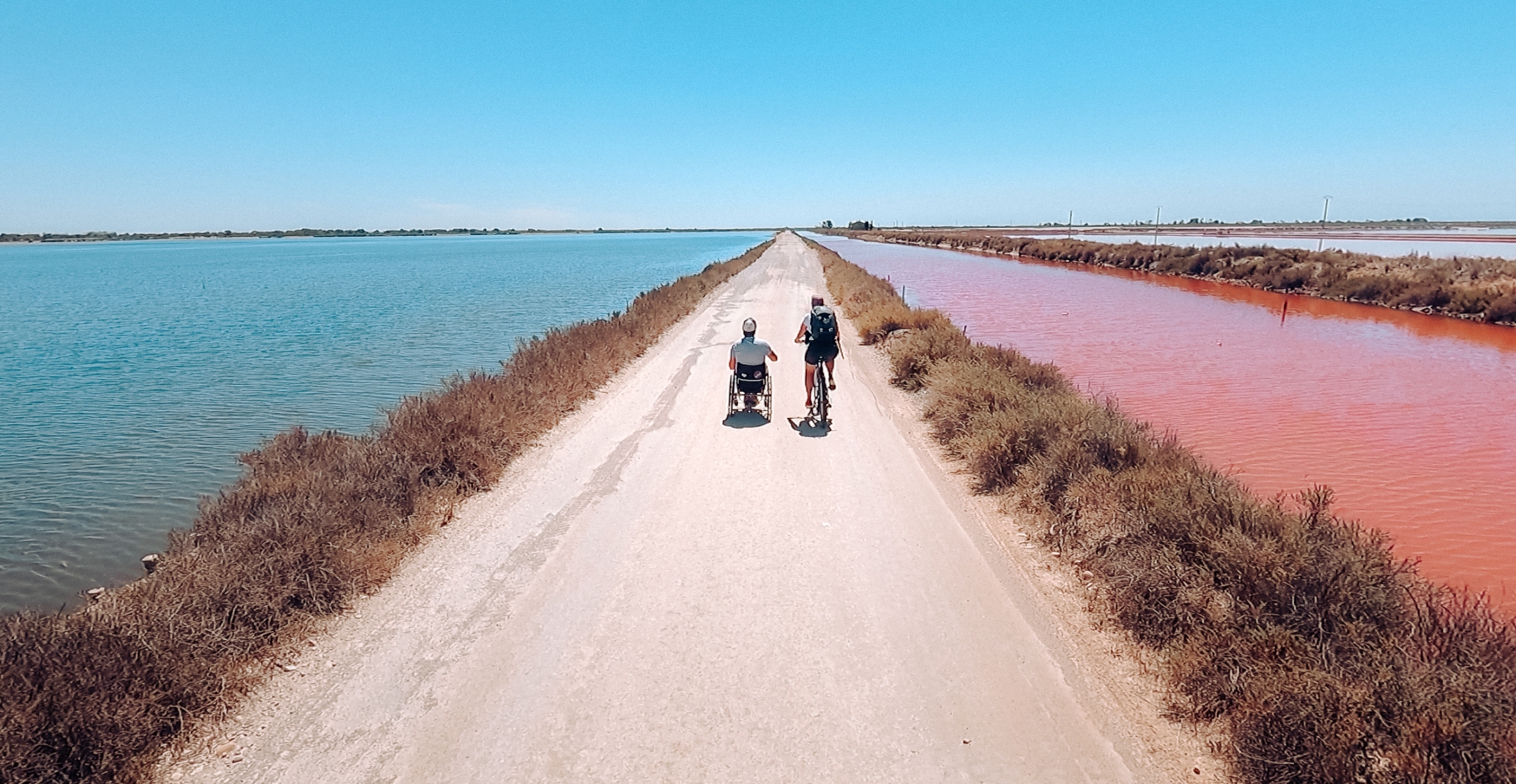OUR TRIP: 5 days on site, from 28 June to 1 July 2021
WHERE ? A stay on the Occitan coast, between Collioure and Aigues Mortes
GETTING AROUND: We advise you to rent a car so that you are free to move around and stop wherever you like
WHY GO THERE? For the colourful streets of the many villages, the fortresses and historic towns, the oyster ponds and the pink salt flats of the Camargue
ACCESSIBILITY : Find all our addresses on our map Mapstr !
In the sunny mildness of the emerging summer, the waves of the Mediterranean come to lick the Occitan coastline, between sharp rocks and fine sandy beaches. From Collioure to Aigues-Mortes, the roads of the coast are adorned with a thousand colours, from the blonde stones of the Cathar fortresses to the colourful walls of the fishing villages, from the dark green of the forests to the emerald of the vineyards, from the royal blue of the sea to the intense pink of the salt flats.
In this enchanting setting, you will be overwhelmed by the spirit of Occitania: a spirit of conviviality and sharing, of traditions and ancestral know-how, of harmony with an omnipresent nature.
In the course of our meetings, we set off for four days to discover the natural, cultural and historical heritage that makes this little piece of coastal Occitania so special.
A meaningful experience... And open to all.
Day 1: The Eastern Pyrenees
Collioure
Collioure is one of the last towns on the Occitan coast before the Spanish border. In the past, its port was the witness of a festival of colours during the sea trips of the Catalan boats. This small boat was used to fish for the anchovies for which the town is famous. Only a few families still produce them, but the boats remain in the port in favour of more massive boats.
Whether you are a fan or not, we advise you to visit the main shop of the Desclaux house. Since 1903, the unique know-how of preparing and preserving anchovies has been passed on from father to son. On the shelves, tins from the early days stand alongside the most recent ones. In salt or oil, you will find what you are looking for thanks to a tasting of the flagship products! The plus: a specialist shows you how to prepare the fillets before putting them in the jars.
On either side of the ramparts, two pebble beaches await you, a real haven of peace sheltered from the wind. In the early morning, the water is still fresh but the first bathers are doing their laps before the holidaymakers arrive.
If it's not the beach, it's the colourful alleys that will charm you. Shops and restaurants open slowly as the sunlight streams through the houses to light your way.
Paulilles
A few kilometres from Collioure, the site of Paulilles is a must. Start with a sea kayak trip to the Sainte Catherine bay at the foot of Cap Béar. Go along the sharp rocks on a sea of oil to get a breath of fresh air.
Once you have got your feet under you, head for the site house. It was here, in 1870, thatAlfred Nobel perfected dynamite by making it more stable and allowing it to be used in tube form on construction sites. Seeing the misuse of his invention during successive wars, he decided to use his fortune to pay tribute to the world's benefactors by creating the Nobel Prizes.
Left abandoned, it was rehabilitated by the departmental authorities a little over 10 years ago with the aim of letting nature take over. An educational trail allows children to learn more about the origins of the place.
At the end of the main path, a boatyard has been set up to bring back to life the Catalan boats left behind by the fishing families. It is also an opportunity for a marine carpenter to train an apprentice for three years who will take over. This trade, which is in decline nowadays, has regained all its nobility.
To complete your visit, we recommend the restaurant Les Clos de Paulilles: freshly grilled tapas a la plancha, a terrace in the heart of the vineyards... what more could you ask for!
Fortress of Salses
On the heights of Salses-le-Château, on the border with the Aude, you can see the ramparts which seem to be buried. It is only when you get there that you realise the size of the fortress of Salses. Built at the end of the 15th century by the Spanish, it was their stronghold in the region to control the border with the kingdom of France. Thanks to its thick walls, about 12 metres thick, and a garrison ready to do anything to protect it. It was not until 1642 that it fell into the hands of the French and by the signing of a peace treaty, the border between the two countries was fixed on the crest of the Pyrenees.
Grand Hotel du Golfe: A comfortable hotel by the sea. The rooms are comfortable, the restaurant is very good and there is also a spa. Rates: From €135 for 2 people. Accessibility: The hotel has accessible rooms. They are well-equipped, you should ask for a shower seat at the reception.
Le Clos des Paulilles: After visiting the site of Paulilles, enjoy delicious tapas! The vineyards of the estate reach right to the heart of the terrace... A magical place! Prices: about 10€ for the tapas and between 16 and 24€ for the dishes. Accessibility: fully accessible to people with reduced mobility.
Anchois Desclaux: Anchovy shop and tasting. Perfect for shopping. Accessibility: The main shop at the top of the town is fully accessible.
Beaches of Collioure: both beaches are accessible thanks to several mats installed at different locations. PRM parking spaces are available nearby. Contact the aid station to check what type of seat they have available.
Site of Paulilles: This former dynamite factory has been completely redesigned to welcome tourists. Accessibility: The site is fully accessible and has obtained the Tourism and Handicap label (mental and deaf). All the paths are accessible by wheelchair. The beach of Paulilles, in the heart of the site, is supervised and the lifeguards provide a tiralo.
Kayak Blue Béar: A great sea kayak trip from the beach of Paulilles. In 1 hour you will go to the Sainte Catherine bay and the Cap Béar. Prices : From 30€ for 3 hours of kayaking. Accessibility: Do not hesitate to contact them to specify your needs. They will help you get into the kayak and adapt the trip to your physical condition.
Fortress of Salses-le-Château: Discover this ancient Spanish fortress built in the 15th century. Rates: 8€/person, free for PRM on presentation of the disability card. Accessibility: Only the main courtyard is accessible for wheelchair users. The cobblestones are uneven, so it is best to have a third wheel. The other rooms of the fortress are accessible only by stairs.
DAY 2: Aude
Narbonne
We leave the Pyrenees Orientales and head for Narbonne, the oldest Roman city in Gaul. It was ideally placed on the road linking Italy to Spain and its port was the second largest in the Mediterranean just behind that of Rome.
When visiting the city, the size of the Cathedral of St. Augustus and St. Pastor is obvious. Construction of the building began in 1272 and was simply never completed. The necessary budget was certainly colossal, but the differing ambitions of the city's leaders at the time did not allow the project to be completed. As a result, only the choir and cloister were built in the mid-13th century. The elements structuring the transept were built but never completed. The town boasts one of the highest vaults in France (the vaults are 41 metres high) and the largest organ in Europe (21 metres high)!
After this visit, we go to La Nautique, the old Roman port has been replaced by a marina and a nautical activity centre. Dominique and his team offer catamaran, windsurfing and kite-surfing courses throughout the year on the Etang de Bages.
Accredited by Tourisme et Handicaps for several years, they are used to receiving people with reduced mobility. They know how to help you get on board and they take no chances with the weather. We are lucky, the tramontana is blowing hard and the boat is speeding towards the other side of the lake.
With our hair frozen in the wind and salt, we set off for Gruissan on the coast. Here the sandy beach stretches for several kilometres, the perfect place for sunset.
This town is also known for its salt marshes, but we are keeping the surprise for the one in Aigues-Mortes!
A Love of Hotel
Le 19 21, un Amour d'Hôtel lives up to its name. Right in the centre of Leucate, this place is a real nugget. Walk through the door and find yourself in a green and peaceful setting.
Refurbished less than 5 years ago, everything is done to make you feel at home. A huge fireplace awaits you for the long winter evenings and a swimming pool on the terrace for the summer. The rooms are comfortable and you will feel as if you are sleeping on a cloud. The next morning, a gourmet breakfast is served with homemade products and local producers.
Be sure to stop by on your way through!
Le 19 21, un Amour d'Hôtel: A charming hotel in the heart of Leucate. Comfortable rooms, a sumptuous breakfast, a swimming pool and a spa make this hotel the perfect place to stay. Rates: From 135€ per night for 2 people. Accessibility: There is at least one accessible room. Ask at reception for their shower chair.
Hotel Douce France: A simple hotel between Narbonne and Béziers. Rates: between 60 and 80€ per night for 2 people. Accessibility: It has the Tourism and Handicap label for all types of disability. There is at least one accessible room and ask at the reception for their shower chair.
Biquet Plage : Have a cocktail or a dish with your feet in the sand. Prices: from 16€. Accessibility: it is fully accessible for people with reduced mobility.
Maison Bebelle : A house specialising in meat dishes. You won't be disappointed! Prices: from 16€. Accessibility: There is a small step to reach the inside of the restaurant. The PRM toilets may be too narrow depending on the size of your wheelchair.
Le Paparazzo : This restaurant is located on the beach of the chalets of Gruissan. One comes here more to enjoy the sunset than for the food. Prices: from 15€. Accessibility: it is fully accessible for people with reduced mobility.
Pôle Nautique de Narbonne: Dominique and his team welcome you a few minutes from Narbonne for an outing on the Etang de Bages. Prices: depend on the type of outing and the boat used. Accessibility: it has been awarded the Tourism and Handicap label since 2012. The team is trained to accompany different types of disabilities on their boats.
Plage des chalets : This beach in Gruissan is wheelchair accessible at the lifeguard station thanks to a carpet. The lifeguard station was closed when we visited but don't hesitate to call them to see if they have a tiralo or a hippocampus.
DAY 3 : The Hérault
The 9 locks of Fonseranes
To continue our journey up the Occitan coast, we stop at the site of the 9 locks of Fonseranes. They are part of the 63 locks spread over the 240 kilometres of the Canal du Midi between Toulouse and Marseillan on the Etang de Thau. Only 6 of them are still in operation, the canal having been diverted since its creation to bypass the town of Béziers.
This project, led by Pierre-Paul Riquet, began in 1667 and was completed in 1682. The techniques employed were revolutionary for the time: the canal bridge was introduced, and its unique water supply system was only made possible by Riquet's knowledge of all the surrounding waterways. The traffic of goods in the south of France was then completely rethought. This was one of the many traces that Louis XIV left behind at the end of his reign.
Every year the number of boats using it increases. It was with the industrial revolution of the 19th century and the heyday of the train that it fell into disuse. In the 1980s, the canal was opened to holidaymakers wishing to enjoy its relaxing rhythm.
The recently renovated site allows you to discover the boats using the locks at your own pace. The difference in height is only 20 metres but it takes 45 minutes to reach the other side!
The site house offers an immersive 15-minute film that traces the history of the canal. If you have the opportunity, don't hesitate to ask them about renting an electric boat or a hydrogen-powered bicycle for a ride along the canal!
Thau Lagoon
The Etang de Thau is known for its aquaculture, particularly that of oysters and mussels. Numerous families share the shellfish farming tables, on which the oysters grow.
Our visit here is in two stages. We start with a boat trip from the port of Mèze to the heart of the tables on the pond to better understand their environment and the difficulties that there can be to work the oyster.
We extend this marine incursion with a visit to the company of Guy Sanchez in the port of Loupian. This family business has been working with oysters for over 60 years and the 4th generation is about to take over. He produces about 400 tons per year thanks to his 50 tables.
The technique implemented on the pond now allows us to have oysters all year round. Unlike the Atlantic coast, the Mediterranean Sea does not have a tidal rhythm. The oyster farmers are therefore obliged to recreate this rhythm so that the oysters grow in the best possible way by taking them out of the water at different times of the day.
As with wine, there are several oyster appellations: Marennes, Bouzigues... To obtain them, the oysters must remain in the same place for a minimum of 6 months. So to diversify the origin of his little jewels, Guy Sanchez set up in Gruissan. The taste, the shape and the flesh are not the same and bring a small twist more than welcome!
We end our day in Balaruc on the edge of the pond to enjoy the sunset, perfect!
Operalia Les Pins: The hotel is located right next to the thermal baths and the promenade along the Etang de Thau. Rates: from €99 per night. Accessibility: the hotel has the Tourism and Handicap label (4 handicaps). A shower chair is available at the reception.
Le 9 : In the heart of the Fonseranes locks site, the terrace of this restaurant offers a superb view of the valley. Prices: menus are between 19 and 29€. Accessibility: it is fully accessible for people with reduced mobility. The toilets are accessible and equipped.
Le Grand Large: On the banks of the Etang de Thau, this restaurant is perfect at sunset! Prices: from 16€. Accessibility: it is fully accessible to people with reduced mobility.
The 9 locks of Fonseranes: This recently renovated site allows you to fully enjoy the locks. It is possible to see an explanatory film on the canal, to rent hydrogen-powered bicycles and small electric boats (you cannot take the locks with them). Prices: €3/adult for the immersive film, the audio tour is free. Accessibility: there are two parking spaces inside the site. The whole site is accessible and the ramp along the locks is quite steep. It is best to have some assistance or an electric wheel.
Catamaran Mansathau : Commented trip on board a catamaran on the Thau lagoon. The circuit passes through the oyster fields. Prices: 13€ for a 55 minute trip. Accessibility: access to the boat is via a ramp from the quay. There are no toilets on board.
Huitres Guy Sanchez : This family business is on the banks of the Etang de Thau. Bonus: an oyster tasting with a glass of white wine. Prices: 7€ for a 1 hour guided tour. They take place from Tuesday to Friday at 2pm and 3pm. Accessibility: The whole site is accessible but there are no toilets.
DAY 4: The Gard
We are finishing our stay in the Gard, on the border with the Camargue. We had wanted to come here for a while, at this particular time, for an event unlike any other.
The salt flats
Every year, between June and July, the salt flats turn pink. A pink like one rarely sees, deep, so intense that one would dream of slipping a foot in it!
Pink? But how? In a 100% natural way, an alga develops in these very salty environments and to survive it produces a pigment which will give the water its pinkish tint. The food chain then makes its way. Small shrimps devour these algae which are themselves eaten by the flamingos! This is how they become pink too!
Several tour formats are possible, but we highly recommend the bike tour. Whether you have your own or take the guided tour, you won't be disappointed! Two routes, one of 12 km and one of 30 km, have been laid out along the salt flats. With a few strokes of the pedal you are alone with the pink flamingos, a moment out of time! Counting our numerous stops, it took us 4 hours to complete the 12 km loop. Don't forget to take enough water, there is no shade on the route and the sun is beating down.
Aigues-Mortes
After these efforts under a blazing sun, we take refuge in the shade of the ramparts ofAigues-Mortes.
The Tower of Constance dominates the city from the top of its 32 metres. In 1242, Louis IX, then King of France, wanted to take advantage of the city's location on the Mediterranean Sea to give the kingdom its first port in this region. He saw the possibility of participating in the maritime trade, which was largely dominated by the Italians. He launched the construction of the Tower of Constance in 1242, which lasted 12 years. Between two departures on the Crusade, he decided to protect the city with immense ramparts that he never saw completely finished. It was in 1302 that Philippe le Bel completed this work of exceptional magnitude.
At the beginning of the 18th century, many Protestant women were locked up in the Tower of Constance. Marie Durand, certainly the most famous, stayed there for 38 years before being released. She is credited with the inscription "Résiste" (Resist) engraved on the edge of the skylight, which is said to have inspired the resistance movement during the Second World War.
Don't hesitate to climb the ramparts, a route has been set up to allow you to visit the Constance tower. The advantage: a global view of the salt marshes!
Le Mas des Sables: A few minutes north of Aigues-Mortes, this hotel is in the heart of the Camargue. The downside is that there are a lot of mosquitoes in the middle of summer. Don't forget to take mosquito repellent and spray. Rates: from 122€ per night for 2 people. Accessibility: several accessible rooms are available. All common areas of the hotel are accessible.
Le Bistro du Splendid : Just in front of the beach, we enjoy a fresh mussel casserole! Prices: from 10.5€. Accessibility: only the terrace is accessible for people with reduced mobility.
Le Salin d'Aigues-Mortes : Just outside the town. They offer guided tours by bike or train. You can also bring your own bike, they don't rent them on site. Prices: 11€/adult, 8,60€/PMR and 8,60€/child. Accessibility: The little train is accessible. If you are going on a bike trip, it is best to have an electric wheel. The first part of the green route (12 km) is passable, the second half the path becomes more difficult, there is a lot of tall grass and stones.
These four days along the Occitanie coastline allowed us to discover many places full of history, from Saint Louis to Alfred Nobel without forgetting Pierre-Paul Riquet. The Mediterranean Sea enhances them with numerous water sports on the many ponds and subtle products like anchovies and oysters.
This stay confirms that the French regions still have some nice surprises to offer us!
We organised this trip with the Comité Régional du Tourisme d'Occitanie and their partners: Pyrénées-Orientales Tourisme, Aude Tourisme, Hérault Tourisme and Gard Tourisme.
It was produced as part of the #JeRedécouvreLaFrance communication and relaunch campaign in partnership with Atout France. Find all the information on this campaign here.

